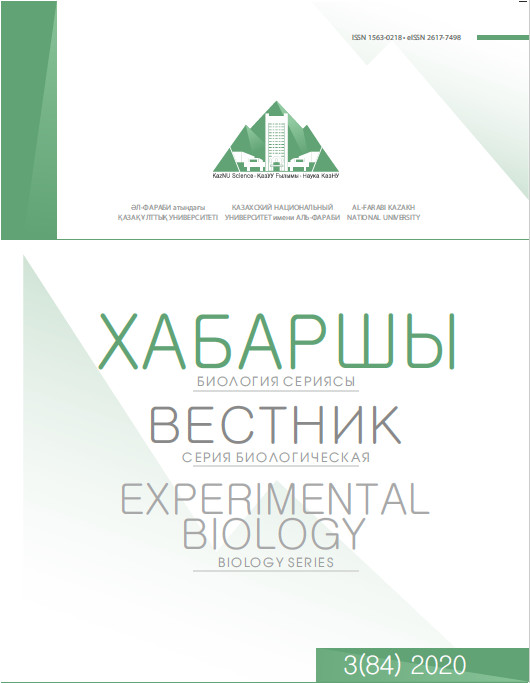Induction of reporter genes expression by ionizing radiation and toxins influence on the Drosophila melanogaster genome
DOI:
https://doi.org/10.26577/eb.2020.v84.i3.07Аннотация
In the human environment, there are many factors that can cause genotoxic and mutagenic effects and one of them is ionizing radiation. Radioactive substances like radon, thorium, radium and their decay products during decomposition are able to emit not only highly penetrating gamma radiation, but also form large heavy alpha-particles. Alpha-particles have a low penetrating power, but high ionization energy, about 10 times greater than gamma-rays. Consequently, we researched genotoxic effects of alpha-radiation using a test-system with reporter genes on the Drosophila melanogaster. In nature, the main source of alpha-particles is colorless radioactive gas radon, its isotopes and daughter decay products. It is technically difficult to create sufficiently intense and directed beams of α-radiation on the long-lived radon isotope – 222Rn. Therefore, for experiments was chosen the 238Pu (Plutonium) isotope, which has the necessary α-line at decay equal to 5.5 MeV. The genotoxic activity of alpha-particles was tested on Drosophila melanogaster with genotype containing genes of luminous proteins. Working of the genetic construction based on the GAL4-UAS system, often used in research to determine gene expression. Genotype also included GADD45 protein gene and GFP gene (green fluorescent protein). This genes combination allows to observe glow of Drosophila organs and tissues after stress factor impact. The sensitivity of construction was checked by chemical mutagen cisplatin, which led to the larvae death at high concentrations, and caused glow of organs at low concentrations. The larvae were exposed to alpha-radiation for 20 hours. Preparations were analyzed on a light microscope with a blue filter and glow of the larval organs was observed. The glow intensity was depending from radiation source. In other words, higher radiation dose caused brighter glow, which correlates with synthesis of luminous protein level. This proves that alpha-radiation from radon and its decay daughter products has a genetic effect.
Keywords: alpha radiation, radon, Drosophila, GFP, genotoxicity.
Библиографиялық сілтемелер
2 Bondarenko L.V., Dukel'skaya A.V. “Metody testirovaniya geneticheskoy aktivnosti faktorov okruzhayushchey sredy.” [“Testing methods for the genetic activity of environmental factors”] Ekologicheskaya genetika 5, no 1 (2007): 42-44. (In Rusian).
3 Shvartsman P.Y. “Indutsirovannyy somaticheskiy mozaitsizm u drozofily kak test-sistema dlya otsenki geneticheskoy aktivnosti faktorov okruzhayushchey sredy.” [“Induced somatic mosaicism in Drosophila as a test system for assessing the genetic activity of environmental factors”] Genetika 11, no 8 (1975): 171. (In Rusian).
4 Karam P. A., Stein B. P. Radioactivity. New York: Chelsea House, 2009.
5 Darby, S. “Radon: A likely carcinogen at all exposures.” Annals of Oncology 2. no 10 (2001): 1341-1351.
6 Torres-Durán M., Ruano-Ravina A., Parente-Lamelas I. et al. “Lung cancer in never-smokers: a case–control study in a radon-prone area (Galicia, Spain).” Eur Respir J 44, no 4 (2014): 850–852. doi: 10.1183/09031936.00017114.
7 Effects of Ionizing Radiation. UNSCEAR 2006 Report: Vol. II. Annex E: Sources-to-effects assessment for radon in homes and workplaces. New York, 2008.
8 Grachev N.N. “Sredstva i metody zashchity ot elektromagnitnykh i ioniziruyushchikh izlucheniy.” [“Means and methods of protection against electromagnetic and ionizing radiation”]. M.: izd-vo MIEM (2005) 215 p. (In Rusian).
9 Chalfie M. et al. “Green fluorescent protein as a marker for gene expression.” Science 263 (1994): 802-805.
10 Dubinin N.P., Sidorov B.N. “Zavisimost' deystviya gena ot yego polozheniya v sisteme.” [“Dependence of the action of a gene on its position in the system”] Biol zhurnal 3, no 2 (1934): 304–331. (In Rusian).
11 Zhimulev I.F., Belyayeva Y.S. “Geterokhromatin i effekt polozheniya gena i geneticheskiy saylensing.” [“Heterochromatin and gene position effect and genetic silencing”] Genetika 39, no 2 (2003): 187-201. (In Rusian).
12 Moskalev A., Shapovnikov M., Snezhkina A. et al. “Mining gene expression data for pollutants (dioxin, toluene, formaldehyde) and low dose of gamma-irradiation.” PLoS One 9, no 1 (2014): e86051.doi.org/10.1371/journal.pone.0086051
13 Guarente, L. “UASs and enhancers: common mechanism of transcriptional activation in yeast and mammals.”Cell 52 (1988): 303-305.
14 Webster N., Jin J. R. Green S. Hollis M. Chambon P. “The Yeast UASG is a transcriptional enhancer in human HeLa cells in the presence of the GAL4 trans-activator.”Cell 52, no 2 (1988): 169–178. doi:10.1016/0092-8674(88)90505-3.
15 Hildesheim J., Bulavin D.V., Anver M.R., et al. “Gadd45a protects against UV irradiation-induced skin tumors, and promotes apoptosis and stress signaling via MAPK and p53.” Cancer research 62 (2002): 7305–7315.
16 Liebermann D.A., Tront J.S., Sha X., et al. “Gadd45 stress sensors in malignancy and leukemia.” Critical reviews in oncogenesis 16 (2011): 129–140.
17 Mоskаlev А., Рlyusninа E., Shароshnikоv M. et аl. “The rоle оf D-GАDD45 in охidаtive, thermаl аnd genоtохiс stress resistаnсe.” Сell Сyсle 11, no 22 (2012): 4222-4241. DOI: 10.4161/cc.22545
18 Liebermann D. A., Hoffman B. “Gadd45 in stress signaling.” J Mol Signal 3 (2008): 1–8.
19 Tamura R.E., de Vasconcellos J.F., Sarkard D., Libermann T.A., Fisher P.B., Zerbinia L.F. “GADD45 proteins: central players in tumorigenesis.” Curr Mol Med 12 (2012): 634–651.
20 Guarente, L., Hoar E. “Upstream activation sites of the CYC1 gene of Saccharomyces cerevisiae are active when inverted but not when placed downstream of the “TATA box.” Proc Natl Acad Sci USA 81, no 24 (1984): 7860-7864.
21 Alberts B.A., Bray D.D., Lewis J.J. “Molecular cell biology: 3rd Edition.” Garland Science (March 1994) 1408 p.
22 Kоhler R. E. “Lоrds оf the fly: Drоsорhilа genetiсs аnd the eхрerimentаl life.” Сhiсаgо: University of Chicago Press (1994) 321 p.
23 Abilev S.K., Glazer V.M. “Mutagenez s osnovami genotoksikologii: Uchebnoye posobiye.” [“Mutagenesis with the basics of genotoxicology: Textbook.”] M.: SPb.: NestorIstoriya (2015) 304 p. (In Rusian).
24 Jamieson E. R. Lippard S. J. “Structure, Recognition, and Processing of Cisplatin−DNA Adducts.” Chemical Reviews 99, no 9 (1999): 2467-2498.
25 Morin X., Daneman R., Zavortink M., Chia W. “A protein trap strategy to detect GFP-tagged proteins expressed from their endogenous loci in Drosophila.” Proc Natl Acad Sci USA 98, no 26 (2001): 15050–15055.




